That’s Thomas Stevens
over there in the picture (click on it!). He left Oakland, California in
1884 on a Columbia Standard (that wheel he’s posing with) and became
the first person to pedal around the world. It took him two years, and when
he was done he wrote an amazing two-volume, 1,000-page story about his adventure.
His book, Around the World on a Bicycle, is a great read and so popular
among collectors that you’ll pay $300 to $400 for the books if you’re
lucky enough to find them (although some older big-city libraries often
have them, they usually won’t let you check them out). Fortunately,
you can now read
it on Google Books.
What’s interesting to me is that lots of cyclists have authored books and lots of writers and artists have been interested in bicycles. Mark Twain for instance wrote an essay called “Taming the Bicycle” (see below) in which he says, “Get a bicycle. You will not regret it — if you live,” a reference to how difficult it was to learn to ride early machines. And H. G. Wells wrote a novel about cycling called The Wheels of Chance. Maybe it’s something about the increase of oxygen to the brain while riding that inspires pedalers to pick up the pen. Ideas certainly come to mind when you’re riding, and it’s not a bad idea to bring along a pad and pencil to capture them.
Often, what comes to mind for me are memorable events, funny things that happened or adventures. On these pages, I share these bicycle stories; some original, some from others, some pictorial. While they’re not all about cycling, the inspiration for them comes from all those miles pedaled while contemplating the universe.
Mark Twain's account of learning to ride a highwheel should be required reading for anyone so inclined . . . (click to view; click again anywhere to hide)
Taming the Bicycle
by Mark Twain
I thought the matter over, and concluded I could do it. So I went down and bought a barrel of Pond’s Extract and a bicycle. The Expert came home with me to instruct me. We chose the back yard, for the sake of privacy, and went to work.
Mine was not a full-grown bicycle, but only a colt — a fifty-inch, with the pedals shortened up to forty-eight — and skittish, like any other colt. The Expert explained the thing’s points briefly, then he got on its back and rode around a little, to show me how easy it was to do. He said that the dismounting was perhaps the hardest thing to learn, and so we would leave that to the last. But he was in error there. He found, to his surprise and joy, that all that he needed to do was to get me on to the machine and stand out of the way; I could get off, myself. Although I was wholly inexperienced, I dismounted in the best time on record. He was on that side, shoving up the machine; we all came down with a crash, he at the bottom, I next, and the machine on top.
 We examined the machine, but it was not in the least injured. This was hardly believable. Yet the Expert assured me that it was true; in fact, the examination proved it. I was partly to realize, then, how admirably these things are constructed. We applied some Pond’s Extract, and resumed. The Expert got on the other side to shove up this time, but I dismounted on that side; so the result was as before.
We examined the machine, but it was not in the least injured. This was hardly believable. Yet the Expert assured me that it was true; in fact, the examination proved it. I was partly to realize, then, how admirably these things are constructed. We applied some Pond’s Extract, and resumed. The Expert got on the other side to shove up this time, but I dismounted on that side; so the result was as before.
The machine was not hurt. We oiled ourselves up again, and resumed. This time the Expert took up a sheltered position behind, but somehow or other we landed on him again.
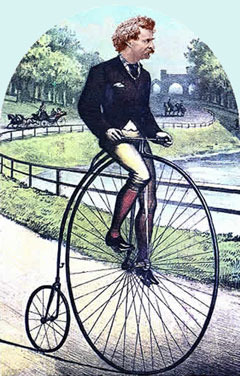 He was full of surprised admiration; said it was abnormal. She was all right, not a scratch on her, not a timber started anywhere. I said it was wonderful, while we were greasing up, but he said that when I came to know these steel spider-webs I would realize that nothing but dynamite could cripple them. Then he limped out to position, and we resumed once more. This time the Expert took up the position of short-stop, and got a man to shove up behind. We got up a handsome speed, and presently traversed a brick, and I went out over the top of the tiller and landed, head down, on the instructor’s back, and saw the machine fluttering in the air between me and the sun. It was well it came down on us, for that broke the fall, and it was not injured.
He was full of surprised admiration; said it was abnormal. She was all right, not a scratch on her, not a timber started anywhere. I said it was wonderful, while we were greasing up, but he said that when I came to know these steel spider-webs I would realize that nothing but dynamite could cripple them. Then he limped out to position, and we resumed once more. This time the Expert took up the position of short-stop, and got a man to shove up behind. We got up a handsome speed, and presently traversed a brick, and I went out over the top of the tiller and landed, head down, on the instructor’s back, and saw the machine fluttering in the air between me and the sun. It was well it came down on us, for that broke the fall, and it was not injured.
Five days later I got out and was carried down to the hospital, and found the Expert doing pretty fairly. In a few more days I was quite sound. I attribute this to my prudence in always dismounting on something soft. Some recommend a feather bed, but I think an Expert is better.
The Expert got out at last, brought four assistants with him. It was a good idea. These four held the graceful cobweb upright while I climbed into the saddle; then they formed in column and marched on either side of me while the Expert pushed behind; all hands assisted at the dismount.
The bicycle had what is called the “wabbles,” and had them very badly. In order to keep my position, a good many things were required of me, and in every instance the thing required was against nature. Against nature, but not against the laws of nature. That is to say, that whatever the needed thing might be, my nature, habit, and breeding moved me to attempt it in one way, while some immutable and unsuspected law of physics required that it be done in just the other way. I perceived by this how radically and grotesquely wrong had been the lifelong education of my body and members. They were steeped in ignorance; they knew nothing — nothing which it could profit them to know. For instance, if I found myself falling to the right, I put the tiller hard down the other way, by a quite natural impulse, and so violated a law, and kept on going down. The law required the opposite thing — the big wheel must be turned in the direction in which you are falling. It is hard to believe this, when you are told it. And not merely hard to believe it, but impossible; it is opposed to all your notions. And it is just as hard to do it, after you do come to believe it. Believing it, and knowing by the most convincing proof that it is true, does not help it: you can’t any more do it that you could before; you can neither force nor persuade yourself to do it at first. The intellect has to come to the front, now. It has to teach the limbs to discard their old education and adopt the new.
The steps of one’s progress are distinctly marked. At the end of each lesson he knows he has acquired something, and he also knows what that something is, and likewise that it will stay with him. It is not like studying German, where you mull along, in a groping, uncertain way, for thirty years; and at last, just as you think you’ve got it, they spring the subjunctive on you, and there you are. No — and I see now, plainly enough, that the great pity about the German language is, that you can’t fall off it and hurt yourself. There is nothing like that feature to make you attend strictly to business. But I also see, by what I have learned of bicycling, that the right and only sure way to learn German is by the bicycling method. That is to say, take a grip on one villainy of it at a time, and learn it — not ease up and shirk to the next, leaving that one half learned.
When you have reached the point in bicycling where you can balance the machine tolerably fairly and propel it and steer it, then comes your next task — how to mount it. You do it in this way: you hop along behind it on your right foot, resting the other on the mounting-peg, and grasping the tiller with your hands. At the word, you rise on the peg, stiffen your left leg, hang your other one around in the air in a general and indefinite way, lean your stomach against the rear of the saddle, and then fall off, maybe on one side, maybe on the other; but you fall off. You get up and do it again; and once more; and then several times.
By this time you have learned to keep your balance; and also to steer without wrenching the tiller out by the roots (I say tiller because it is a tiller; “handle-bar” is a lamely descriptive phrase). So you steer along, straight ahead, a little while, then you rise forward, with a steady strain, bringing your right leg, and then your body, into the saddle, catch your breath, fetch a violent hitch this way and then that, and down you go again.
But you have ceased to mind the going down by this time; you are getting to light on one foot or the other with considerable certainty. Six more attempts and six more falls make you perfect. You land in the saddle comfortably, next time, and stay there — that is, if you can be content to let your legs dangle, and leave the pedals alone a while; but if you grab at once for the pedals, you are gone again. You soon learn to wait a little and perfect your balance before reaching for the pedals; then the mounting-art is acquired, is complete, and a little practice will make it simple and easy to you, though spectators ought to keep off a rod or two to one side, along at first, if you have nothing against them.
And now you come to the voluntary dismount; you learned the other kind first of all. It is quite easy to tell one how to do the voluntary dismount; the words are few, the requirement simple, and apparently undifficult; let your left pedal go down till your left leg is nearly straight, turn your wheel to the left, and get off as you would from a horse. It certainly does sound exceedingly easy; but it isn’t. I don’t know why it isn’t, but it isn’t. Try as you may, you don’t get down as you would from a horse, you get down as you would from a house afire. You make a spectacle of yourself every time.
During eight days I took a daily lesson of an hour and a half. At the end of this twelve working-hours’ apprenticeship I was graduated — in the rough. I was pronounced competent to paddle my own bicycle without outside help. It seems incredible, this celerity of acquirement. It takes considerably longer than that to learn horseback-riding in the rough.
Now it is true that I could have learned without a teacher, but it would have been risky for me, because of my natural clumsiness. The self-taught man seldom knows anything accurately, and he does not know a tenth as much as he could have known if he had worked under teachers; and, besides, he brags, and is the means of fooling other thoughtless people into going and doing as he himself had done. There are those who imagine that the unlucky accidents of life — life’s “experiences” — are in some way useful to us. I wish I could find out how. I never knew one of them to happen twice. They always change off and swap around and catch you on your inexperienced side. If personal experience can be worth anything as an education, it wouldn’t seem likely that you could trip Methuselah; and yet if that old person could come back here it is more than likely that one of the first things he would do would be to take hold of one of these electric wires and tie himself all up in a knot. Now the surer thing and the wiser thing would be for him to ask somebody whether it was a good thing to take hold of. But that would not suit him; he would be one of the self-taught kind that go by experience; he would want to examine for himself. And he would find, for his instruction, that the coiled patriarch shuns the electric wire; and it would be useful to him, too, and would leave his education in quite a complete and rounded-out condition, till he should come again, some day, and go to bouncing a dynamite-can around to find out what was in it.
But we wander from the point. However, get a teacher; it saves much time and Pond’s Extract.
Before taking final leave of me, my instructor inquired concerning my physical strength, and I was able to inform him that I hadn’t any. He said that that was a defect which would make up-hill wheeling pretty difficult for me at first; but he also said the bicycle would soon remove it. The contrast between his muscles and mine was quite marked. He wanted to test mine, so I offered my biceps — which was my best. It almost made him smile. He said, “It is pulpy, and soft, and yielding, and rounded; it evades pressure, and glides from under the fingers; in the dark a body might think it was an oyster in a rag.” Perhaps this made me look grieved, for he added, briskly: “Oh, that’s all right; you needn’t worry about that; in a little while you can’t tell it from a petrified kidney. Just go right along with your practice; you’re all right.”
Then he left me, and I started out alone to seek adventures. You don’t really have to seek them — that is nothing but a phrase — they come to you.
I chose a reposeful Sabbath-day sort of a back street which was about thirty yards wide between the curbstones. I knew it was not wide enough; still, I thought that by keeping strict watch and wasting no space unnecessarily I could crowd through.
Of course I had trouble mounting the machine, entirely on my own responsibility, with no encouraging moral support from the outside, no sympathetic instructor to say, “Good! now you’re doing well — good again — don’t hurry — there, now, you’re all right — brace up, go ahead.” In place of this I had some other support. This was a boy, who was perched on a gate-post munching a hunk of maple sugar.
He was full of interest and comment. The first time I failed and went down he said that if he was me he would dress up in pillows, that’s what he would do. The next time I went down he advised me to go and learn to ride a tricycle first. The third time I collapsed he said he didn’t believe I could stay on a horse-car. But next time I succeeded, and got clumsily under way in a weaving, tottering, uncertain fashion, and occupying pretty much all of the street. My slow and lumbering gait filled the boy to the chin with scorn, and he sung out, “My, but don’t he rip along!” Then he got down from his post and loafed along the sidewalk, still observing and occasionally commenting. Presently he dropped into my wake and followed along behind. A little girl passed by, balancing a wash-board on her head, and giggled, and seemed about to make a remark, but the boy said, rebukingly, “Let him alone, he’s going to a funeral.”
I had been familiar with that street for years, and had always supposed it was a dead level; but it was not, as the bicycle now informed me, to my surprise. The bicycle, in the hands of a novice, is as alert and acute as a spirit-level in the detecting of delicate and vanishing shades of difference in these matters. It notices a rise where your untrained eye would not observe that one existed; it notices any decline which water will run down. I was toiling up a slight rise, but was not aware of it. It made me tug and pant and perspire; and still, labor as I might, the machine came almost to a standstill every little while. At such times the boy would say: “That’s it! take a rest — there ain’t no hurry. They can’t hold the funeral without you.”
Stones were a bother to me. Even the smallest ones gave me a panic when I went over them. I could hit any kind of a stone, no matter how small, if I tried to miss it; and of course at first I couldn’t help trying to do that. It is but natural. It is part of the ass that is put in us all, for some inscrutable reason.
I was at the end of my course, at last, and it was necessary for me to round to. This is not a pleasant thing, when you undertake it for the first time on your own responsibility, and neither is it likely to succeed. Your confidence oozes away, you fill steadily up with nameless apprehensions, every fiber of you is tense with a watchful strain, you start a cautious and gradual curve, but your squirmy nerves are all full of electric anxieties, so the curve is quickly demoralized into a jerky and perilous zigzag; then suddenly the nickel-clad horse takes the bit in its mouth and goes slanting for the curbstone, defying all prayers and all your powers to change its mind — your heart stands still, your breath hangs fire, your legs forget to work, straight on you go, and there are but a couple of feet between you and the curb now. And now is the desperate moment, the last chance to save yourself; of course all your instructions fly out of your head, and you whirl your wheel away from the curb instead of toward it, and so you go sprawling on that granite-bound inhospitable shore. That was my luck; that was my experience. I dragged myself out from under the indestructible bicycle and sat down on the curb to examine.
I started on the return trip. It was now that I saw a farmer’s wagon poking along down toward me, loaded with cabbages. If I needed anything to perfect the precariousness of my steering, it was just that. The farmer was occupying the middle of the road with his wagon, leaving barely fourteen or fifteen yards of space on either side. I couldn’t shout at him — a beginner can’t shout; if he opens his mouth he is gone; he must keep all his attention on his business. But in this grisly emergency, the boy came to the rescue, and for once I had to be grateful to him. He kept a sharp lookout on the swiftly varying impulses and inspirations of my bicycle, and shouted to the man accordingly:
“To the left! Turn to the left, or this jackass’ll run over you!” The man started to do it. “No, to the right, to the right! Hold on! that won’t do! — to the left! — to the right! — to the left! — right! left — ri — Stay where you are, or you’re a goner!”
And just then I caught the off horse in the starboard and went down in a pile. I said, “Hang it! Couldn’t you see I was coming?”
“Yes, I see you was coming, but I couldn’t tell which way you was coming. Nobody could — now, could they? You couldn’t yourself — now, could you? So what could I do?”
There was something in that, and so I had the magnanimity to say so. I said I was no doubt as much to blame as he was.
Within the next five days I achieved so much progress that the boy couldn’t keep up with me. He had to go back to his gate-post, and content himself with watching me fall at long range.
There was a row of low stepping-stones across one end of the street, a measured yard apart. Even after I got so I could steer pretty fairly I was so afraid of those stones that I always hit them. They gave me the worst falls I ever got in that street, except those which I got from dogs. I have seen it stated that no expert is quick enough to run over a dog; that a dog is always able to skip out of his way. I think that that may be true; but I think that the reason he couldn’t run over the dog was because he was trying to. I did not try to run over any dog. But I ran over every dog that came along. I think it makes a great deal of difference. If you try to run over the dog he knows how to calculate, but if you are trying to miss him he does not know how to calculate, and is liable to jump the wrong way every time. It was always so in my experience. Even when I could not hit a wagon I could hit a dog that came to see me practise. They all liked to see me practise, and they all came, for there was very little going on in our neighborhood to entertain a dog. It took time to learn to miss a dog, but I achieved even that.
I can steer as well as I want to, now, and I will catch that boy out one of these days and run over him if he doesn’t reform.
Get a bicycle. You will not regret it, if you live.
Born in Bordeaux, France in 1932, Jean-Jacques Sempé is one of the truly great illustrators, especially of bicycles, bicyclists, bicycle shops and . . . (more)
What do: a derailleur gear, an aluminum frame, the freewheel,
disc wheels, anatomical saddles, clipless pedals, suspension, folding bikes
have in common? Answer: they were all ideas that originated in the late
1800s . . . (more)
The address in my notebook says Madison Avenue, so naturally I'm expecting tall buildings full of guys and dolls in swanky duds, the type who . . . (more)
Up until I was about 35, I could ride or not ride and still feel pretty good on the bike as long as the riding I was doing was quality riding. Yet, only a couple of years later, even a single day off left me feeling stale and stiff and unhappy on the bike. So, in 1990, I set a goal of streak cycling for ten years . . . (more)
A brilliant 30-minute cycling comedy from 1947 starring the wonderful Jacques Tati, also known as Mr. Hulot (Flash player required; broadband connection recommended) . . . (more)
Here are a few fun bicycle stereocards. Way before television (about 1860 to the turn of the century), these special photographs were a way to capture and view interesting scenery and events with almost three-dimensional realism . . . (more)
Plenty of people have machines onto which they hop to roll back time. And I’m one of them. What’s the gimmick? An antique bicycle, more specifically, a highwheel bicycle . . . (more)
Instead of the manmade barriers used today, courses then were designed to force crossers over and through as many natural obstacles as possible, including creeks and rivers, huge downed redwood logs, mud pits, barbed wire . . . (more)
It pains me no end to have to report that that dastardly Red Robin handily stomped me into the ground last night at the Swanton Time Trial . . . (more)
The most important job every morning was lighting the big sheet-metal stove in the center of the shop . . . (more)
They cost next to nothing. They're easily found. They're not held in high esteem by other two-wheel junkies. Yet, to this collector, they're among the most interesting of bicycle artifacts . . . (more)
I really got into cycling in 1971 after buying my first good road bike. There was a lot to learn, so I gathered what books I could find. One, Richard’s Bicycle Book by Richard Ballantine, is still a favorite. It’s now dog-eared and yellowed but . . . (more)
You might find it interesting to learn that I knew of Santa Cruz’s reputation as a bike town when I first got into cycling because it’s where the author of Anybody’s Bike Book, the number-one bike book in the early seventies, came from . . . (more)
I had worked at West Hill Shop in Putney, Vermont for about six months in 1978, when Jan VanderTuin walked in one day with a pair of wheels and asked to look at tubular tires. I knew who he was. He’d been in before, and my boss/mentor Neil Quinn, the owner of West Hill, had told me how VanderTuin had raced a bit in Vermont, done pretty well and had then headed west . . . (more)
When I started running I had a close friend and training partner named John. He was a year behind me in school but was born to run. While I ran twice a day to improve and compete, he flew on several runs a week. And even when he was just beginning, he could . . . (more)
At one time, Schwinn had one of the finest bicycle collections in the world. But the goods (estimated to include over a million items) belonged to the Schwinn family; not the company. Unable to continue to house and display the bikes and memorabilia, the family decided to sell the entire collection at an auction in Chicago, which I attended. It was a bittersweet affair. . . . (more)
See the many strange ways the bicycle changed from the early 1800s to the late thirties in this interactive bicycle history. . . . (more)
A photo essay from my one trip to Moab (1996). We're approaching the top of the Porcupine Rim trail and about to experience one of the nicest downhill runs there is. . . . (more)
![]()
![]()

![]()

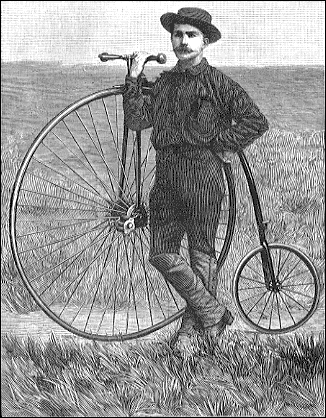

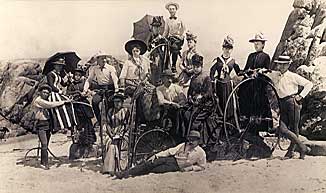
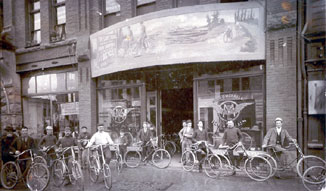
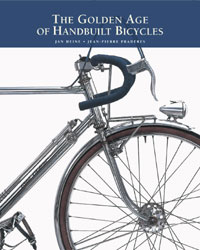
 We examined the machine, but it was not in the least injured. This was hardly believable. Yet the Expert assured me that it was true; in fact, the examination proved it. I was partly to realize, then, how admirably these things are constructed. We applied some Pond’s Extract, and resumed. The Expert got on the other side to shove up this time, but I dismounted on that side; so the result was as before.
We examined the machine, but it was not in the least injured. This was hardly believable. Yet the Expert assured me that it was true; in fact, the examination proved it. I was partly to realize, then, how admirably these things are constructed. We applied some Pond’s Extract, and resumed. The Expert got on the other side to shove up this time, but I dismounted on that side; so the result was as before. He was full of surprised admiration; said it was abnormal. She was all right, not a scratch on her, not a timber started anywhere. I said it was wonderful, while we were greasing up, but he said that when I came to know these steel spider-webs I would realize that nothing but dynamite could cripple them. Then he limped out to position, and we resumed once more. This time the Expert took up the position of short-stop, and got a man to shove up behind. We got up a handsome speed, and presently traversed a brick, and I went out over the top of the tiller and landed, head down, on the instructor’s back, and saw the machine fluttering in the air between me and the sun. It was well it came down on us, for that broke the fall, and it was not injured.
He was full of surprised admiration; said it was abnormal. She was all right, not a scratch on her, not a timber started anywhere. I said it was wonderful, while we were greasing up, but he said that when I came to know these steel spider-webs I would realize that nothing but dynamite could cripple them. Then he limped out to position, and we resumed once more. This time the Expert took up the position of short-stop, and got a man to shove up behind. We got up a handsome speed, and presently traversed a brick, and I went out over the top of the tiller and landed, head down, on the instructor’s back, and saw the machine fluttering in the air between me and the sun. It was well it came down on us, for that broke the fall, and it was not injured.
